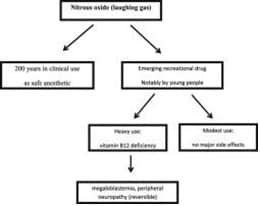Nitrous oxide, one of the first modern anesthetics, was first manufactured in 1772 by English chemist, Joseph Priestly. Nitrous oxide was used for the first time as a dental anesthetic drug in 1844.Every year approximately 45 million dental patients undergo anesthesia, A significant percentage of general dentists use nitrous oxide sedation in their practices to manage pain, anxiety, and excessive gag reflex. Nitrous is the most used gaseous anesthetic in the world, commonly administered for the purpose of decreasing the amount of more potent and usually more toxic agents during general anesthesia cases.
Properties and Mechanism of Action
Nitrous oxide produces analgesic (pain killing) and anxiolytic (anxiety reduction) effects. Nitrous oxide is the weakest of the inhalant anesthetics used for patient sedation in dentistry or medicine. The chemical formula is N2O. The gas is colorless, non-flammable, with a slightly sweet odor.
Nitrous oxide has low solubility in blood, diffuses rapidly across the alveolar-arterial membrane and is excreted unchanged through the lungs. As a result, nitrous takes effect rapidly and is quickly reversible on discontinuation. Nitrous oxide can induce loss of consciousness at high concentrations, typically 70% or higher. Nitrous oxide produces either no change, or a slight increase in blood pressure, while all other volatile anesthetics reduce blood pressure. There is no effect on heart rate, but high doses may cause myocardial depression.
Nitrous oxide gas is used in both the medical and dental professions to ensure patient comfort during procedures. A 40%-70% N2O mixture (the remainder consisting of oxygen) is used as an adjunct to inhalation and IV general anesthesia. The gaseous 9 mixture is administered using either a mask, nasal canula, or an endotracheal tube. The onset of action for N2O is between 2-5 minutes.
Uses in Clinical Dentistry Indications :
- A fearful, anxious, or obstreperous patient.
- Certain patients with special health care needs.
- A patient whose gag reflex interferes with dental care .
- A patient for whom profound local anesthesia cannot be obtained.
- A cooperative child undergoing a lengthy dental procedure 10 Contraindications.
- Some chronic obstructive pulmonary diseases.
- Severe emotional disturbances or drug-related dependencies.
- First trimester of pregnancy.
- Treatment with bleomycin sulfate.
- Methylenetetrahydrofolate reductase deficiency (B12).
The contraindications for use of nitrous are important especially when considering that nitrous oxide is the only inhaled anesthetic proven to be teratogenic (causing birth defects) in animals, so is to be avoided in the first trimester of pregnancy. Patients with pulmonary hypertension or major cardiac disease should be evaluated carefully and in consultation with the medical doctor before using nitrous. Patients with severely compromised cardiac function are not candidates for nitrous oxide sedation because of the slight myocardial depressant action of the gas on the circulatory system. And patients who are claustrophobic may be unable to tolerate a nasal mask although use of a nasal canula may solve the issue. Some patients may fear “losing control” of themselves and adamantly refuse N2O sedation. Patients with persistent nasal congestion or obstruction or who unable to breathe comfortably through the nose, may not be candidates for nitrous oxide sedation.

Reference: The Academy of Dental Learning and OSHA Training, LLC.
